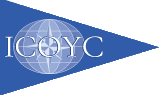Lighthouses & Lightships
What the Canadian Coast Guard refers to as Aids to Navigation (buoys, lighted or not, lighthouses, range markers, etc.) have gone through all kinds of changes, modifications, relocations, and elimination on Lake St. Louis during the last one hundred years, and even over the past two or three years, as we know too well. Too often, for "economic" reasons, the most recent changes did not always constitute navigational aids to yachtsmen, who sometimes find them rather confusing.
The early nautical charts of Lake St. Louis formerly published by the Department of the Naval Services of Canada, of which our Club has the good fortune of possessing the 1912 updated version of the 1890-1906 edition (on a cloth backing and in a perfect state of conservation) are fascinating and have a lot to tell us. They bring us back to a period, half a century before the existence of the St. Lawrence Seaway, a time when substantial marine traffic cruised Lake St. Louis along its northern shore, from the Ottawa River and the St. Anne's lock, and along the South shore, from the St. Lawrence River and the Soulanges Canal, all converging towards the Lachine Canal and Montreal. Our old updated chart shows two lighthouses, which were in existence by 1902. They are long gone, but their locations remain well known to us. They were very similar in design, comprising an elevated stone and concrete base on which stood a small two-story structure providing living accommodation and fuel and supplies storage, surmounted by a circular lantern containing an oil or gas-fueled lamp, 37-38 feet above water level.
The first lighthouse, known as the Pointe-Claire Lighthouse, was located on the spot that we refer to as The Gut, next to the AD 18 red buoy facing Pointe Charlebois. It already existed in 1902 and completely disappeared in the last century. All that is left of it is the submerged pile of rocks which we avoid carefully. The second lighthouse, known as the Dorval Lighthouse, was located where the half-submerged rocky ledge may now be seen at low water levels, surrounded by three small yellow markers near the AD 14 buoy facing the Pointe de Valois. This spot, which serves as a haven for sea birds, is dreaded by all sailors. There again, a weakened crib foundation and successive assaults from ice flow during the spring breakup progressively destroyed the old lighthouse, strategically located at the junction of the North channel leading into Lachine. I remember that stopping there as a child when crossing Lake St. Louis in my dinghy, and climbing on what was left of the old lighthouse, then a 45° tilted concrete platform on which sat a pair of slanted gas tanks surmounted by a light. The whole thing eventually collapsed altogether, creating a very dangerous obstacle to navigation.
The old chart clearly shows that the Dorval lighthouse had also served as a range marker for the alternate channel between Dorval Island and the shore, which was subsequently marked by a few buoys of which only AS 2 and AS 3 remain near the Dorval Island ferry boat crossing, moved upstream this year for unknown reasons. It was a shortcut to Lachine passing in front of our Club, used by pleasure craft and apparently by Oka Sand barges, hauled by steam tug boats from the Oka beaches on Lake of Two Mountains to the Lachine Canal and Montreal.
Another even more interesting revelation from our 1890-1912 chart is the existence of two lightships that existed as far back as 1902, anchored during the navigation season at two other strategic locations in Lake St. Louis. They consisted of a red-painted steel hull marked Lake St. Louis No. 12 and No. 13, surmounted by a little cabin and a white lighthouse. These lighthouses stood 20 and 26 feet respectively above water level. They served to mark channel junctions and shoals as well as range markers. The first lightship was anchored where the Lachine B buoy is now located, between the present-day AC 45 and AC 48 buoys at the junction of the North and South channels. The St. Lawrence Seaway did not yet exist at the time. The second lightship was anchored further upstream between the present AC 57 and AC 59 buoys.
The late Paul Baby, a venerable and much-missed Honorary Life Member of our Club who passed away in 2002 at the age of 98, whose memory was fabulous, was one of the very few persons who remembered those lightships. They were replaced by the different fixed lights, buoys, and other devices now dotting our lake, including the 81-foot Dixie Island range lighthouse which has served navigation since 1915. The only other subsisting ones from those days are the two lighthouses at the Lachine Federal wharf (now turned over to the municipal authorities). They still serve pleasure craft heading towards Lachine and the re-opened Lachine Canal. The two Lake St. Louis lighthouses and lightships featured in this article left official traces in the History of Dorval. The old valuation rolls of the Village of Dorval, separated from Lachine in 1892, show amongst its residents, whether owners or tenants, more than one listed as "lighthouse keeper." Paul Baby had once told me that the husband of his mother's charwoman was a lighthouse keeper and that she was crossing over to work by rowboat.
Excerpt from an article by the late Michel Pasquin, former Member and Honorary Archivist of the RSTLYC.
Originally published in the October 2003 issue of the Foghorn.



